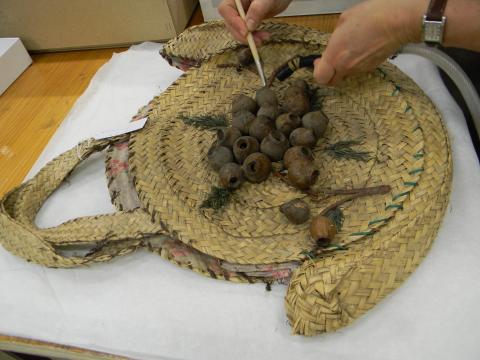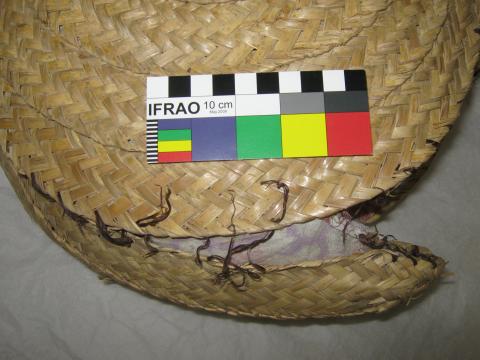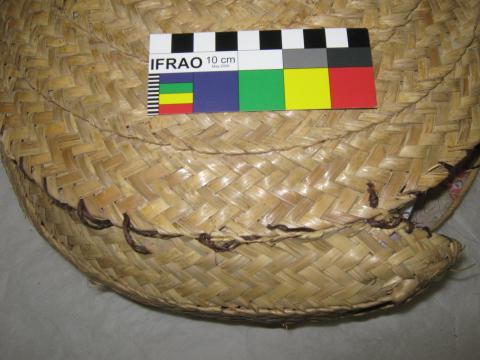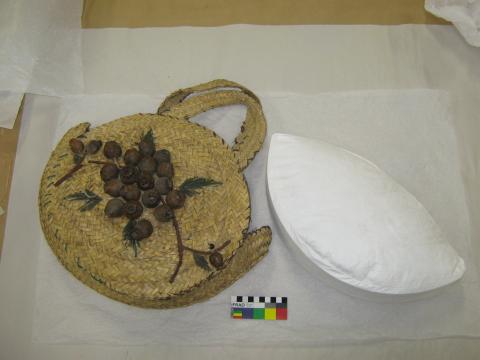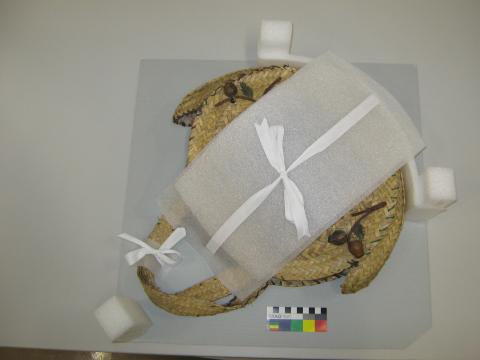Mount Margaret Woven Basket
C. Corvaia
Introduction
The basket was made some time before 1947 and was obtained during a visit to Melbourne by a group of Mount Margaret school children. The woven basket was donated to the Western Australian Museum by Grace and Joyce Dodge in 2010. The basket was made by stitching a plaited fibre strip. Two circles, formed in a spiral pattern, were joined at the sides and base by a wide band and two handles were added at the top.
Condition
The basket had been flattened during storage and dust and dirt had accumulated on the decorated (upper) side. The other side was relatively clean with only a few brown stains visible. The decoration of eucalyptus ‘gum’ nuts had suffered some damage. Several gum nuts had abrasion losses, some sticks were broken and there were losses of the fragile green raffia stitching. The plaited fibre strips had frayed and broken edges, especially on the handles and at the top of the sides. The dark brown raffia stitching was broken and missing in areas and plastic-coated wire had been used for repairs on these joins. The textile lining of the basket was detached along the top and had stains, dirt, creases and frayed edges.
Treatment
The distortion of the shape and loss of stitching were placing stresses on the object. The accumulated dust and dirt were contributing to the deterioration of the natural fibres and continued handling caused further losses of the fragile green and dark brown raffia stitching.
Proposed treatment of the basket involved:
- dry cleaning of the surfaces (Figure 6);
- dehumidification and re-shaping (Figure 7);
- repair of loose and broken stitching (Figure 8);
- construction of an internal support to maintain the shape of the basket (Figure 9); and
- packing for storage (Figure 10).
In order to safely re-shape the flattened basket, the fibres needed to be humidified to increase their flexibility. Before introducing moisture to the natural fibres, the basket surfaces were cleaned using dry methods, with a brush and vacuum to remove loose dust. The basket was then placed on a supporting screen in a humidification chamber. During the first four hours of humidification the basket was constantly checked and balls of tissue paper were used as padding to progressively restore the correct shape. The following day the basket was removed from the humidification chamber and allowed to air dry. The tissue paper padding was left inside the basket while work continued. The decorated side of the basket, which still had a film of dirt, was cleaned with damp cotton buds using deionised water. Care was taken to lift the dirt out of the textured surfaces (not push it further into the weave) and to avoid the areas of fragile raffia.
Figure 6: Surface cleaning the basket.
Figure 7: Basket in the dehumidification chamber during re-shaping.
All the loose and broken stitching on the basket required stabilising to avoid further losses. The loose ends of brown raffia binding on the decoration were humidified, re-wound, secured in position to dry and then attached with methyl cellulose adhesive. Elsewhere, the brown raffia stitching had loose, brittle ends associated with losses. These were carefully manipulated into the woven plait joins and uncoloured natural raffia (a good colour match for the plaited fibre material) was used to secure the joins. The top edges of the basket at both sides had extensive loss of brown raffia stitching and the cotton lining was loose. Uncoloured raffia was used to re-stitch the lining in place, threading the blunt needle through the existing needle holes in the cotton fabric (Figure 8).
Figure 8: (a) Basket before repair of the seam between right side and back panels.
(b) Basket after repair using uncoloured raffia.
The tissue paper padding inside the basket was replaced with a more stable support which would not change over time. An internal support was constructed using Tyvek® to form a circular ‘bag’ which conformed to the inside shape of the shopping basket. Part of the perimeter was made slightly rigid with an Ethafoam™220 insert (fitted into a gusset) and Dacron™ sheeting was used for padding (Figure 9). The internal support extended to the edges of the circular sides but was not visible at the top, so that the basket could be displayed without further modifications to the support.
Figure 9: Basket and its internal support.
To avoid direct handling of the basket and further losses of fragile fibres, the basket was placed on an acid-free corrugated board and secured in position with Ethafoam™220, Cell-Aire® and cotton tapes. The board was fitted into a box and secured for short-term storage and travel. The shopping basket was displayed at the WA Museum of the Goldfields in Kalgoorlie in 2010.
Figure 10: Basket packed for transport.













